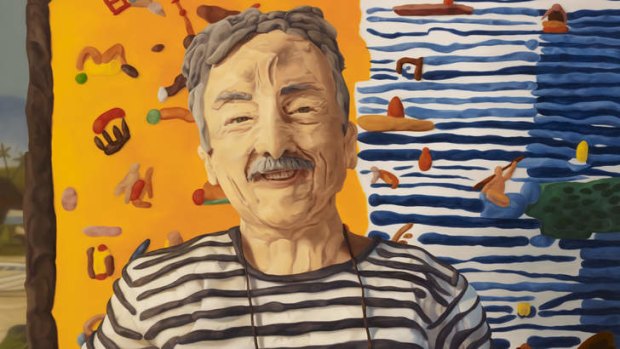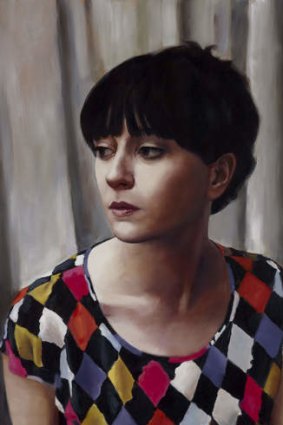By John McDonald
This column comes from Japan, where, like a character in a horror story pursued by an implacable nemesis, I'm writing about the Archibald Prize. This venerable portrait competition is an Australian institution that is incomprehensible to the rest of the world. To outsiders the popularity of the prize, and of portraiture in general, is a mysterious Aussie phenomenon that must have something to do with sunstroke or snakebite.
The real reason may be nothing more than the ingrained empiricism of Australian life. Perhaps as a legacy of our pioneering background, Australians are not much given to philosophy or abstract thinking. We are not dreamers, revolutionaries or writers of manifestos. We prefer things that are solid and quantifiable - scenarios in which success or failure is a matter of who runs fastest or scores more points.

The chosen one: Ken Done by Amanda Marburg.
Many people see no reason art shouldn't be judged on similar grounds. A portrait is a recognisable image of a person, so the best likeness is obviously the best picture. By this criterion, Vincent Fantauzzo should run away with the Archibald every year, with his highly refined photorealist style. He is back this year with a wall-sized, detail-perfect portrait of Asher Keddie, and is again favourite for the People's Choice.
Or maybe the empiricists would prefer one of those endearing portraits of children, such as Marcus Callum's Portrait of the Artist as a Young Man, or Joshua McPherson's Ella. It can't be denied these pictures are very nicely painted, albeit cloying.

Genuinely likeable: Heidi Yardley's self-portrait.
As usual it would be futile to mention the terms of the prize that call for the subject to be ''preferentially of some man or woman distinguished in Art, Letters, Sciences or Politics''. The weasel word is ''preferentially''. It doesn't require a legal opinion to realise this means: ''Anything goes.''
If we leave the bedrock of a ''good likeness'', and ask what other criteria we might use to judge a successful portrait, we arrive at the Packers' Prize, decided unilaterally by chief packer Steve Peters. Steve's worldview is less complex than that of most art lovers: he gives the prize, every year, to a picture of a good sort or a good bloke. This time around it went to Matthew Lynn's portrait of good sort Tara Moss.
Matthew Lynn has contributed accomplished portraits to previous Archibalds, but this is not one of his better efforts. Moss comes across as characterless and prettified, even her pose feels constricted. Three years ago, Lynn entered an excellent portrait of Pierre Ryckmans, only to see it rejected from both the Archibald and the Salon de Refuses. Perhaps the trustees also have a sneaking preference for good sorts.
Beyond this point we stray into the wilderness of subjectivity, where good and bad become a matter of taste, persuasive argument and compromise. More than any year I can remember, this year the field seems wide open. As I'm writing almost a week in advance of the announcement, I can only speculate which way the trustees will jump.
The hanging provides a few crucial clues. At a preview last year, Tim Storrier's winning entry was found on a wall near the entrance, but by the day of the announcement it had been moved to the central gallery. You can be sure any work that remains anchored in those first rooms is not a serious contender, even if some of these pieces are preferable to many that hog the spotlight. Heidi Yardley's Self-portrait - Harlequin, for instance, is an unassuming but genuinely likeable painting. One could say the same about Natasha Bienek's tiny self-portrait, although its exaggeratedly small dimensions lend the work a hint of affectation.
On a very different scale there is Paul Noble's Jo, a monumental portrait of artist Joanna Braithwaite, which is reminiscent of those prog rock album covers designed by Paul Whitehead. Noble captures his subject well, although in every other sense he is trying too hard to attract attention.
Even this painting seems relatively conservative alongside Michael Lindeman's Dear Trustees (Self Portrait 2013), which takes the form of an extended begging letter to the judges, with a sketchy self-portrait at the end. It's basically a gag, and not nearly as witty as some of Lindeman's previous efforts.
As for Joshua Yeldham's Self-Portrait - Morning Bay, it is extremely hard to identify the sitter, unless we assume he is disguised as a large owl. Somehow, in the context of the Archibald, this seems perfectly plausible. I'm tempted to try the same disguise next year for the press preview. Peter Daverington might have been better as an owl, but he seems to prefer the role of disembodied clown in a pointy hat.
However, if you're really looking for gimmicks, look no further than Carlo Pagoda's Habit de Jardinier, with a semi-invisible subject covered in rococo twirls made by marker pen on a sheet of stainless steel - a very unpleasant effect. With a French title to boot.
One can't accuse Wang Xu of gimmickry, although his self-portrait, surrounded by the faces of Chinese dissidents, is like nothing that has ever been shown in the Archibald before. There is an anger and commitment in this work that shows up the trivial nature of so many other entries. I'd like to think it is more than an attempt to give some variety to the hang. In terms of skill and content, it is superior to almost anything else in the show.
The prime real estate in any Archibald exhibition is the central gallery. On the left and right sides of the main doorway, you find Del Kathryn Barton's portrait of Hugo Weaving, and Alexander McKenzie's Toni Colette. Position alone makes them contenders, although it would be unlikely for the trustees to go with Barton again, after having given her the prize in 2008. The days when William Dargie or Ivor Hele took out the Archibald year after year are long gone. Contemporary taste craves variety.
Neither can one be entirely convinced by McKenzie's portrait. I obviously haven't been following Toni Colette's career closely enough, because I don't know why she's pictured standing in front of a yellow inflatable life raft, like the Madonna framed by a Gothic arch. Neither is it immediately apparent why Arnold Bocklin's Isle of the Dead looms up in the work's background. The picture is executed with McKenzie's usual skill, but the symmetry of the composition is stultifying.
Looming above these pictures is David Griggs' psychedelic portrait of artist TV Moore, positioned over the doorway. This work has more life about it than many other entries, although it is not an appealing prospect to stare for any length of time into that blaze of lurid red.
Equally unappealing is the pall of gloom into which Michael Vale has plunged an unusually static Warren Ellis. There must have been a better way to portray such a character, rather than plonk him down on some barren windswept landscape, looking like Magwitch from Great Expectations.
Jason Benjamin's McLean Edwards is more successful than Edwards' own painting of curator Glenn Barkley, which fails on the simplest of grounds by not capturing a likeness. Abbey McCulloch is even further from the truth in her Naomi Watts, who looked a lot healthier turning green on a hospital bed in The Impossible.
If the trustees are pining for a big head because they gave it to a figure last year, they might scrutinise Benjamin's portrait, or Jasper Knight's picture of the late Adam Cullen, who looks as cute as a puppy. They shouldn't be looking too hard at James Powditch's Ben Quilty, as Quilty is now on the board and it would be a bad precedent if they started to give the prize to portraits of acting trustees.
Although the prize is a glorified lucky dip this year, I wonder if it mightn't be Amanda Marburg's turn? She has form, having come close in the past, and her style - a painting based on a photo of a Plasticine model - has just enough novelty to make it seem a daring choice. Even the subject is slightly daring, being Ken Done - the successful artist who is despised by less successful artists because of his ''commercialism''.
As the biggest annual money-spinner for the AGNSW, it would be highly appropriate if the Archibald Prize celebrated an artist who has never recognised any barriers between creativity and commerce. This is, after all, the obligatory position of everybody working in a public gallery nowadays.
THE ARCHIBALD PRIZE
Art Gallery of NSW, until June 2